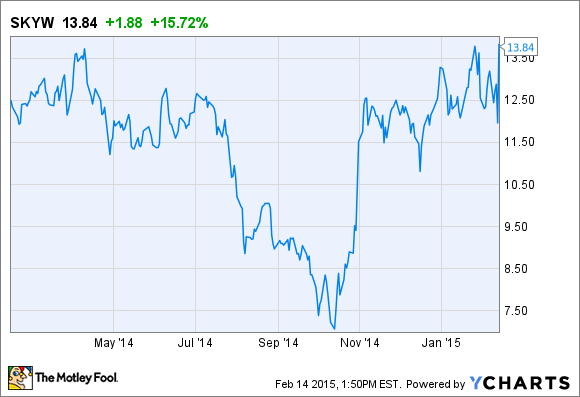On Thursday, SkyWest, (SKYW -5.87%) reported solid Q4 earnings. EPS more than doubled year-over-year to $0.31, easily beating the average analyst estimate of $0.13. Surprisingly, SkyWest shares still crashed on Thursday.
On Friday, investors thought better of their initial reaction. By the end of the day, SkyWest stock had soared nearly 16%, reaching a new 52-week high in the process.
SkyWest 1 Year Stock Chart, data by YCharts
Investors' second reaction to the SkyWest earnings release was probably the right one. SkyWest is finally showing that it is serious about remaking its business in the image of its smaller -- but more successful -- rival, Republic Airways (NASDAQ: RJET). In the long run, this should lead to better earnings results.
Fleet quality is improving
The past couple of years have been challenging for SkyWest. Like other regional airlines, it mainly flies smaller planes on behalf of the big network carriers. But SkyWest's airline partners have been trying to reduce their use of the smallest regional aircraft, which seat 50 or fewer passengers.
As of mid-2014, SkyWest still operated 501 50-seat jets, plus another 45 30-seat turboprops. By contrast, it only operated 211 large regional jets, which are favored by the network carriers today.

SkyWest is gradually increasing the proportion of large regional jets in its fleet. Photo: The Motley Fool
However, SkyWest is working to sign new contracts for large regional jets while downsizing its fleet of small regional jets and turboprops. It is currently in the midst of phasing in a contract to fly 40 Embraer (ERJ -1.28%) E-175 76-seat jets with United Continental. It also recently signed a smaller contract to fly 7 E-175s for Alaska Air.
Meanwhile, SkyWest is shrinking the number of 50-seat jets it flies for United. SkyWest also announced in late 2014 that it will retire all of its remaining turboprops by mid-2015 and that it has moved up the end date for its 50-seat jet contract with United by 3 years, from 2020 to 2017.
The net result of these moves is that by the end of 2015, SkyWest expects to operate 389 50-seat jets and 247 large regional jets. This will mark a significant improvement in SkyWest's fleet mix compared to mid-2014.
Profitability is normalizing
SkyWest reported significant losses in the first half of 2014. Some of the key drivers were severe winter weather that caused numerous flight cancellations, increased pilot costs due to new federal regulations and more training events, and poor operational performance.
However, the earnings trajectory is already improving. SkyWest earned a solid profit in Q3 and was also profitable in Q4 before the impact of aircraft write-offs related to the ongoing transition toward large regional jets. The management team also expects that SkyWest will post a much better first-half earnings performance in 2015 than it did last year.
Republic has made more progress
SkyWest is clearly on the right track, but its smaller rival Republic Airways is much further along in the transition to large regional jets. Today, large regional jets already represent about 70% of Republic's fleet.
Indeed, Republic has now laid out firm plans to move to an all-large regional jet fleet in the next 2 years. Last May, the company announced that it would eliminate the 50-seat Embraer E145 and the 99-seat Embraer E-190 from its fleet by mid-2016, leaving it with just 2 aircraft types.
In September, Republic reached an agreement with mainline partner United that will allow it to remove its 31 Q400 turboprops from service by the end of 2016. At the same time, it signed a contract to fly an additional 50 E-175s for United.
As a result, Republic Airways will operate a single fleet type of Embraer E-Jets by the end of next year. Not only will it have removed all of the less-profitable aircraft types from its fleet, Republic will also have simplified its operations, making it much more efficient.
While SkyWest is moving in the right direction, 50-seat jets will remain a significant part of its business for the foreseeable future. By contrast, the ultimate goal of operating a single fleet type of large regional jets is already in sight for Republic Airways. Although there is plenty of long-term upside for SkyWest stock, Republic looks like a much safer bet today.






